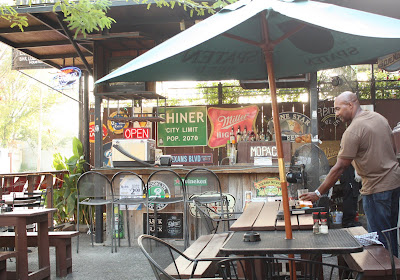Today I went to Sam Houston Park with my friend, Katie, during lunch to practice using the manual setting on our cameras. A couple of weeks ago Katie and I went to a photography class at Hermann Park. Besides learning about photo composition and how to use the Manual setting, I came away with a renewed sense of excitement towards photography. Katie and I decided that, even though it is 100+ degrees outside at noon every day, we would spend one lunch break per week practicing photography.
:: It is fun to have photo-taking buddy ::
 |
| This is Katie! (Not me, Katie, but my photo bud, Katie.) |
 |
| Our subject today was the church. |
 |
Cute green shutters.
|
I also wanted to quickly share some of the lessons taught at our class by {
Jimmy Loyd}.
Six Guidelines of Photography Composition:
1. Simplicity
· Keep it simple
· Fill in the frame, and don’t leave any dead space.
· Make sure there are no distracters in the background of the photo
2. Frames
· Frames help keep your eyes in the photo
· You can frame your subject with circles, squares, two people, trees, etc.
· Not every photo has to have a frame
3. Balance
· Extra people and/or items in the photo will help tell the story
4. Lines
· Your eyes follow lines until they end
· Lines in the shape of the letter “S” or “C” are very peaceful
· Diagonal lines often mean action is going on
· For scenery, don’t let the horizon line cut your picture in half
5. Rule of Thirds
· If you were to make a tic-tac-toe board across your photo, your subject should be where the lines intersect
· Don’t worry about this rule with group shots
6. Mergers
· Don’t let your subject and your background merge together to deform your subject
· Ex: child sitting in front of a fountain looks like he has water spouting out of his head.
· Don’t cut your pictures at the joints (elbows, knees, etc.)
Five Steps of the Manual Setting:
1. White Balance
2. Image Quality
· Small = Low Quality
· Medium = Medium Quality
· Large = Best Quality
3. ISO (International Standard Organization)
· Sunny = 100-200
· Shady/Indoors = 200-400
· Darker/Night = 800-1600
· Remember, less light means you need a higher ISO
4. Aperture
· 5.6 = letting in a lot of light
· 16 = letting in very little light
· Remember, for a bright place you need less light coming into the photo
· Going up the scale is letting in less light
· A lower number creates a more narrow focus
· For landscapes, use a higher aperture
5. Shutter Speed
· Controls the action by controlling the light that goes into the camera
· A higher bottom number lets less light in and stops the action more (ex: 1/1000 lets in less light than 1/60)
 |
| up close and personal |
 |
| fierce. |
All photos on this entry were shot in manual. It is starting to get easier!
































